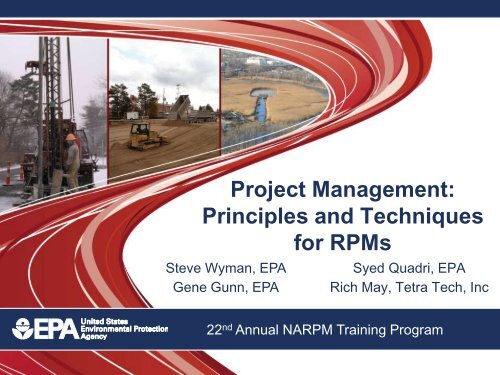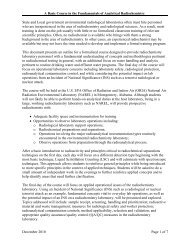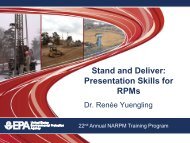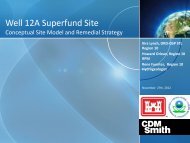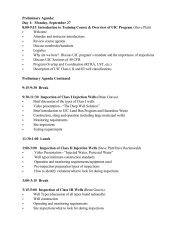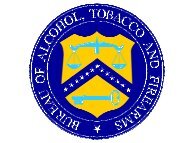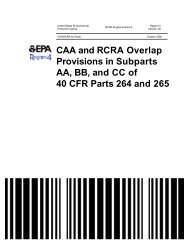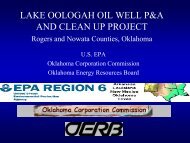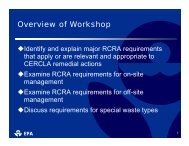Project Management - (NARPM) Training Program
Project Management - (NARPM) Training Program
Project Management - (NARPM) Training Program
Create successful ePaper yourself
Turn your PDF publications into a flip-book with our unique Google optimized e-Paper software.
<strong>Project</strong> <strong>Management</strong>:Principles and Techniquesfor RPMsSteve Wyman, EPAGene Gunn, EPASyed Quadri, EPARich May, Tetra Tech, Inc22 nd Annual 2222<strong>NARPM</strong> <strong>Training</strong> <strong>Program</strong> nd Annual nd Annual <strong>NARPM</strong> <strong>Training</strong> <strong>Program</strong><strong>NARPM</strong> <strong>Training</strong> <strong>Program</strong>0
Module One: IntroductionRich May22 nd Annual 2222<strong>NARPM</strong> <strong>Training</strong> <strong>Program</strong> nd Annual nd Annual <strong>NARPM</strong> <strong>Training</strong> <strong>Program</strong><strong>NARPM</strong> <strong>Training</strong> <strong>Program</strong>1
Instructor Introductions Rich May Syed Quadri Steve Wyman Gene Gunn22 nd Annual <strong>NARPM</strong> <strong>Training</strong> <strong>Program</strong>22 nd Annual <strong>NARPM</strong> <strong>Training</strong> <strong>Program</strong>2
Participant Survey By show of hands:• How many of you are EPA RPMs?• How many are State project managers?• How many are EPA HQ personnel?• How many have had some formal <strong>Project</strong><strong>Management</strong> training?• How many are interested in or have thoughtabout becoming certified <strong>Project</strong> Managers?22 nd Annual <strong>NARPM</strong> <strong>Training</strong> <strong>Program</strong>22 nd Annual <strong>NARPM</strong> <strong>Training</strong> <strong>Program</strong>3
General Logistics Questions /discussions – Strike Balance• Encouraging open discussions• Staying on track Breaks and lunch• Morning break – 10:30 a.m. to 10:45 a.m.• Lunch on your own – 12:30 p.m. to 1:30 p.m.• Afternoon break – 3:00 p.m. to 3:15 p.m. Location of restrooms Emergency procedures Cell phone etiquette22 nd Annual <strong>NARPM</strong> <strong>Training</strong> <strong>Program</strong>22 nd Annual <strong>NARPM</strong> <strong>Training</strong> <strong>Program</strong>4
Course Objectives After taking this course participants will beable to:• Apply several project management techniques totheir remediation projects• Define strategic project management and applythe concepts to their remediation projects• Create high performing teams that help create andutilize dynamic project management tools• Realize the value of some of the higher levelproject management processes22 nd Annual <strong>NARPM</strong> <strong>Training</strong> <strong>Program</strong>22 nd Annual <strong>NARPM</strong> <strong>Training</strong> <strong>Program</strong>5
Review of the Day First half of the day• An introduction to SEMS• Review foundational material and describevarious project management tools• Demonstrate how these tools are applied anddiscuss how they provide value to any project• Focus on how to develop and use some specifictools Second half of the day• Small Group Exercises• A Detailed look at SEMS22 nd Annual <strong>NARPM</strong> <strong>Training</strong> <strong>Program</strong>22 nd Annual <strong>NARPM</strong> <strong>Training</strong> <strong>Program</strong>6
Let’s Begin At . . .22 nd Annual <strong>NARPM</strong> <strong>Training</strong> <strong>Program</strong>22 nd Annual <strong>NARPM</strong> <strong>Training</strong> <strong>Program</strong>7
SEMS IntroductionSteve Wyman, OSRTI22 nd Annual 2222<strong>NARPM</strong> <strong>Training</strong> <strong>Program</strong> nd Annual nd Annual <strong>NARPM</strong> <strong>Training</strong> <strong>Program</strong><strong>NARPM</strong> <strong>Training</strong> <strong>Program</strong>8
SEMS Introduction SEMS Vision SEMS Tool Suite Oracle Primavera & the Work Breakdown Structure Deployment schedule and next steps22 nd Annual <strong>NARPM</strong> <strong>Training</strong> <strong>Program</strong>22 nd Annual <strong>NARPM</strong> <strong>Training</strong> <strong>Program</strong>9
SEMS VisionIntegrates three primary Superfund data systems into oneoverarching enterprise information management system• CERCLIS (Comprehensive Environmental Response, Compensation,and Liability Information System)• SDMS (Superfund Document <strong>Management</strong> System)• ICTS (Institutional Controls Tracking System)• Other smaller systems also integratedSupports five program offices (OSRTI, OSRE, OEM, FFRRO,FFEO) and all ten regional offices.Fully integrated system will allow the program to accurately andconsistently plan, track and report activities and resources.22 nd Annual <strong>NARPM</strong> <strong>Training</strong> <strong>Program</strong>22 nd Annual <strong>NARPM</strong> <strong>Training</strong> <strong>Program</strong>10
SEMS Governance StructureSEMS Steering Committee· Office of Superfund Remediation and Technology Innovation (OSRTI), Office Director· Federal Facilities Restoration and Reuse Office (FFRRO), Office Director· Federal Facilities Enforcement Office (FFEO), Office Director· Office of Site Remediation & Enforcement (OSRE), Office Director· Office of Emergency <strong>Management</strong> (OEM), Office Director· Regional Office LeadsOffice of Solid Waste (OSWER)Senior Operations Council (SOC)· Information <strong>Management</strong> Officer (IMO)· Senior Information Official (SIO)Advisors(as necessary)Change Advisory Board (CAB)· OSRTI, Office Lead· OSWER Information <strong>Management</strong> Coordinator (Super IMC)· Regional Representation (one or more TBD)· Office of Emergency <strong>Management</strong> (OEM), Office Lead· Federal Facilities Restoration and Reuse Office (FFRRO), OfficeLead· Office of Site Remediation & Enforcement (OSRE), Office Lead· Federal Facilities Enforcement Office (FFEO), Office LeadSMEsSuperfundInformation<strong>Management</strong>Working Group(SIMWG)SEMS <strong>Project</strong>ManagerIntegrated <strong>Project</strong>Team (IPT)· Office of the Chief Financial Officer(OCFO), Senior Budget Officer (SBO)· Office of Environmental Information (OEI)Representative· Information Security Officer (ISO)· Quality Information Council (QIC)Representative· Enterprise Architecture (EA) Team· Information Investment Subcommittee (IIS)· Office of Acquisition <strong>Management</strong> (OAM)Representative· OSRTI Security (ASSERT) Team· Privacy Act Officer (PAO)· Agency Records OfficerHeadquarters Data<strong>Management</strong>· Division Director (DD)· Headquarters DataSponsor- Subject:- Branch:RegionalRepresentatives· Remedial <strong>Project</strong> Manager (RPM)· On-Scene Coordinator (OSC)· Information <strong>Management</strong>Coordinators (IMC)· Budget Coordinator· Records Manager· System Administrative· Regional ManagerRegional SubjectMatter Experts· Health Effects (HE)· Institutional Controls(IC)· Others, asnecessasryLegalRepresentatives· Office of Enforcementand ComplianceAssurance (OECA)· Office of GeneralCounsel and Office ofRegional Counsel22 nd Annual <strong>NARPM</strong> <strong>Training</strong> <strong>Program</strong>22 nd Annual <strong>NARPM</strong> <strong>Training</strong> <strong>Program</strong>11
SEMS Component Suite Primavera: <strong>Project</strong> & <strong>Program</strong> <strong>Management</strong> P6 Analytics: Measurement and Analysis Business Intelligence: Reporting & Dashboard Tool Universal Records Manager: Certified Records<strong>Management</strong> System WebCenter: Document Repository, Portal, Dynamic<strong>Management</strong> and Loading of Web Content Secure Enterprise Search: Across Platform FileSearches Supporting FOIA & eDiscovery Fusion Middleware: Forms, Workflow, BusinessProcess Modeling, Web Services22 nd Annual <strong>NARPM</strong> <strong>Training</strong> <strong>Program</strong>22 nd Annual <strong>NARPM</strong> <strong>Training</strong> <strong>Program</strong>12
CERCLIS vs. SEMSRegions will be using Oracle Primavera to manage siteschedules in SEMS• Powerful project management tool already used by USACE andmany of our construction contractors• Allows us to more fully and consistently adopt projectmanagement in SuperfundCERCLIS was custom-built to meet our needs at the time• Significant effort has been made to map existing CERCLISactions to the new Primavera Work Breakdown Structure (WBS)CERCLIS “actions” = Primavera WBS “work packages”22 nd Annual <strong>NARPM</strong> <strong>Training</strong> <strong>Program</strong>22 nd Annual <strong>NARPM</strong> <strong>Training</strong> <strong>Program</strong>13
Work Breakdown StructureBackbone of planning, managing, controlling & reporting aproject• Organizes & defines the total scope of a projectDesigning the WBS involves subdividing the project scope anddeliverables into smaller, more manageable componentsWBS tracks multiple levels of activities, durations, resources, andrelationships• Also multiple ways to view progress and run scenariosSEMS will have a standard WBS template for use at all sites22 nd Annual <strong>NARPM</strong> <strong>Training</strong> <strong>Program</strong>22 nd Annual <strong>NARPM</strong> <strong>Training</strong> <strong>Program</strong>14
PRIMAVERAWORK BREAKDOWNSTRUCTURE22 nd Annual <strong>NARPM</strong> <strong>Training</strong> <strong>Program</strong>22 nd Annual <strong>NARPM</strong> <strong>Training</strong> <strong>Program</strong>15
22 nd Annual <strong>NARPM</strong> <strong>Training</strong> <strong>Program</strong>22 nd Annual <strong>NARPM</strong> <strong>Training</strong> <strong>Program</strong>16
22 nd Annual <strong>NARPM</strong> <strong>Training</strong> <strong>Program</strong>22 nd Annual <strong>NARPM</strong> <strong>Training</strong> <strong>Program</strong>17
22 nd Annual <strong>NARPM</strong> <strong>Training</strong> <strong>Program</strong>22 nd Annual <strong>NARPM</strong> <strong>Training</strong> <strong>Program</strong>18
Rolling Out the WBSPhase I Pilot (FY2012)• Region 7 has been developing the WBS and piloting it at severalsites Phase II Pilot (Began October 2012 )• Region 7 efforts resulted in “WBS 1.0” to be tested next byRegions 1, 3, 4 and 6• Feedback will result in further refinement of the WBS prior to fullmigration of site data from CERCLIS Data Migration (Spring/Summer 2013)• QA of data in CERCLIS prior to migration• Confirm successful migration once data is in SEMS22 nd Annual <strong>NARPM</strong> <strong>Training</strong> <strong>Program</strong>22 nd Annual <strong>NARPM</strong> <strong>Training</strong> <strong>Program</strong>19
Next Steps for SEMSSEMS is much bigger than just the WBS!• Budget planning and Compass connection• Site-level info (e.g. GPRA measures)• Enforcement, Federal Facilities and Removal program data• Linking documents / records management• And much more…Requirements are nearly complete for all program areasDevelopment of screens and functionality is ongoingExtensive training is under development• Hands-on computer training, webinars, self-guided modules22 nd Annual <strong>NARPM</strong> <strong>Training</strong> <strong>Program</strong>22 nd Annual <strong>NARPM</strong> <strong>Training</strong> <strong>Program</strong>20
Deployment Schedule Data migration, testing and training will begin in Spring 2013Fully integrated system will be delivered to the stagingenvironment by September 30, 2013CERCLIS will remain the official reporting system for theprogram for all of FY2013• Parallel operations will be necessary for a short period of timeSEMS is expected to move into production in the first quarter ofFY2014!22 nd Annual <strong>NARPM</strong> <strong>Training</strong> <strong>Program</strong>22 nd Annual <strong>NARPM</strong> <strong>Training</strong> <strong>Program</strong>21
Syed Quadri, PMPRegion 5 RPMMODULE TWO – PROJECTMANAGEMENT BACKGROUND& COMMUNICATION22 nd Annual <strong>NARPM</strong> <strong>Training</strong> <strong>Program</strong>22 nd Annual <strong>NARPM</strong> <strong>Training</strong> <strong>Program</strong>22
<strong>Project</strong> <strong>Management</strong> BackgroundTopics to be covered:• Benefits of using PM tools• PMI and PMBOK• Strategic <strong>Project</strong> <strong>Management</strong>• Communicating Effectively22 nd Annual <strong>NARPM</strong> <strong>Training</strong> <strong>Program</strong>22 nd Annual <strong>NARPM</strong> <strong>Training</strong> <strong>Program</strong>23
Typical Problems withSuperfund <strong>Project</strong>s Unclear requirements or ARARs Ambiguous and unclear project goals &stakeholder expectations Unknown influences impacting cost and timedue to the nature of our projects Regional and Headquarters goals/prioritiesnot clearly understood Scope Creep Lack of ownership by team22 nd Annual <strong>NARPM</strong> <strong>Training</strong> <strong>Program</strong>22 nd Annual <strong>NARPM</strong> <strong>Training</strong> <strong>Program</strong>24
Typical Problems With <strong>Project</strong>s(Continued) Poor project planning at the beginning Lack of regular re-planning duringimplementation Delayed projects without any recovery plans Ambiguity on the steps required toaccelerate the delayed projects Lack of info on major milestones/due dates Not knowing the critical path of the project22 nd Annual <strong>NARPM</strong> <strong>Training</strong> <strong>Program</strong>22 nd Annual <strong>NARPM</strong> <strong>Training</strong> <strong>Program</strong>25
More Problems WithSuperfund <strong>Project</strong>s Lack of project risk assessment & monitoring <strong>Project</strong> schedule based on guesswork Lack of availability of <strong>Project</strong> <strong>Management</strong>tools Conflicting and shifting priorities andrequirements Lack of good communication plan Minimal stakeholder support22 nd Annual <strong>NARPM</strong> <strong>Training</strong> <strong>Program</strong>22 nd Annual <strong>NARPM</strong> <strong>Training</strong> <strong>Program</strong>26
<strong>Project</strong> <strong>Management</strong> Identify <strong>Project</strong> Objectives & Needs Application of tools, skills, knowledge & techniques Balancing competing demands of triple constraints –Understand your drivers A project life cycle has five process groups:• Initiating or Conceptualization• Planning• Execution or Implementation• Monitoring/Controlling &• Closing22 nd Annual <strong>NARPM</strong> <strong>Training</strong> <strong>Program</strong>22 nd Annual <strong>NARPM</strong> <strong>Training</strong> <strong>Program</strong>27
Five Process GroupsInitiatingClosingMonitoringandControllingPlanningExecuting22 nd Annual <strong>NARPM</strong> <strong>Training</strong> <strong>Program</strong>22 nd Annual <strong>NARPM</strong> <strong>Training</strong> <strong>Program</strong>2828
9 Knowledge AreasCenters of Expertise22 nd Annual <strong>NARPM</strong> <strong>Training</strong> <strong>Program</strong>22 nd Annual <strong>NARPM</strong> <strong>Training</strong> <strong>Program</strong>29
<strong>Project</strong> <strong>Management</strong> StepsPlan the Work and Then Workthe PlanMeasure the AccomplishmentsAgainst the Plan22 nd Annual <strong>NARPM</strong> <strong>Training</strong> <strong>Program</strong>22 nd Annual <strong>NARPM</strong> <strong>Training</strong> <strong>Program</strong>30
<strong>Project</strong> <strong>Management</strong> Process Define the project objective. (Scope) Divide and subdivide the project (WBS) Define the specific activities that need to be performed(Activity Definition) Graphically portray the activities in a network diagram(Activity Sequencing) Make a time estimate (Precursor to the Schedule) Make a cost estimate (Precursor to the Budget) Calculate a project schedule and budget (Create a Baseline)22 nd Annual <strong>NARPM</strong> <strong>Training</strong> <strong>Program</strong>22 nd Annual <strong>NARPM</strong> <strong>Training</strong> <strong>Program</strong>31
<strong>Project</strong> <strong>Management</strong> Planning, executing and monitoring are threecritical skills for a project manager Establish clear & achievable objectives• SMART Goals• Outcome based not activity based Adapting specs/plans/approach tostakeholder requirements22 nd Annual <strong>NARPM</strong> <strong>Training</strong> <strong>Program</strong>22 nd Annual <strong>NARPM</strong> <strong>Training</strong> <strong>Program</strong>32
<strong>Project</strong> <strong>Management</strong>: OperationalVs Strategic What is Operational <strong>Project</strong> <strong>Management</strong>? What is Strategic <strong>Project</strong> <strong>Management</strong>?Is there a Distinction between the two?What difference does it make?22 nd Annual <strong>NARPM</strong> <strong>Training</strong> <strong>Program</strong>22 nd Annual <strong>NARPM</strong> <strong>Training</strong> <strong>Program</strong>33
Traditional <strong>Project</strong> <strong>Management</strong>ParadigmWith Good Stakeholder CommunicationMoreConstraints:Risk &Resources22 nd Annual <strong>NARPM</strong> <strong>Training</strong> <strong>Program</strong>22 nd Annual <strong>NARPM</strong> <strong>Training</strong> <strong>Program</strong>34
Traditional vs. Strategic <strong>Management</strong>Traditional PMStrategic PMFocus Effectiveness & Business ResultsEfficiencyPerspective Operational Strategic, OperationalMgr’s Role Get the job done/in time Businessbudget, specsResultsPlanning Budget, Schedule ValueActivitiesHuman Side Team, conflict Resolution Leadership/vision/spirit22 nd Annual <strong>NARPM</strong> <strong>Training</strong> <strong>Program</strong>22 nd Annual <strong>NARPM</strong> <strong>Training</strong> <strong>Program</strong>35
Strategic <strong>Project</strong> <strong>Management</strong> Narrow the scope of organizational strategyfor the <strong>Project</strong>-Develop <strong>Project</strong> Strategy Remember that Strategy is about CreatingValue (the way to success) Creating overall purpose22 nd Annual <strong>NARPM</strong> <strong>Training</strong> <strong>Program</strong>22 nd Annual <strong>NARPM</strong> <strong>Training</strong> <strong>Program</strong>36
What is the most important skillfor a project manager?What percentage of time atypical project manager spendsin communication?22 nd Annual <strong>NARPM</strong> <strong>Training</strong> <strong>Program</strong>22 nd Annual <strong>NARPM</strong> <strong>Training</strong> <strong>Program</strong>37
Communication <strong>Management</strong> Identify Stakeholders Plan Communications Distribute Information <strong>Management</strong> Stakeholder Expectations Report Performance22 nd Annual <strong>NARPM</strong> <strong>Training</strong> <strong>Program</strong>22 nd Annual <strong>NARPM</strong> <strong>Training</strong> <strong>Program</strong>38
Complexity of Communication How many communication channels are therewhen you have 4 stakeholders? How many communication channels are therewhen you have 10 stakeholders?22 nd Annual <strong>NARPM</strong> <strong>Training</strong> <strong>Program</strong>22 nd Annual <strong>NARPM</strong> <strong>Training</strong> <strong>Program</strong>39
Communication Understand personality types. Avoid “Communication Traps” Choose the right communication method.• Interactive Communication (Meetings, phone)• Push Communication (letters, press release)• Pull Communication (intranet, e-learning) Learn meeting management skills.• Agenda• Facilitation Tips• Presentation Skills Keep team members informed and included!22 nd Annual <strong>NARPM</strong> <strong>Training</strong> <strong>Program</strong>22 nd Annual <strong>NARPM</strong> <strong>Training</strong> <strong>Program</strong>40
Communication Don’t just “hear and be heard”…understand andbe understood.• “timely” and “appropriate”• collection and distribution of information• ask the right questions and actively listen• diffuse emotions and use specific examples & facts Bond that holds the team together. Builds trust and cooperation among diversestakeholders. Prerequisite for leadership & problem solving. Good communication can never be an overkill!22 nd Annual <strong>NARPM</strong> <strong>Training</strong> <strong>Program</strong>22 nd Annual <strong>NARPM</strong> <strong>Training</strong> <strong>Program</strong>41
PowerHighStakeholders - Power/Interest GridKeepSatisfiedManageCloselyMediaSenators,MayorsMonitorMinimum EffortCommunityKeep InformedGeneral Public,CommunityLowInterestHigh22 nd Annual <strong>NARPM</strong> <strong>Training</strong> <strong>Program</strong>22 nd Annual <strong>NARPM</strong> <strong>Training</strong> <strong>Program</strong>42
Communication Plan for communication with team &stakeholders.• Identifying key stakeholders (internal and external)• <strong>Project</strong> <strong>Management</strong> Plan• Community Involvement Plan• Risk communication• Working with the media Identify & craft key messages. Get buy in by getting input. Manage your management. Use PM tools to assist with communication.22 nd Annual <strong>NARPM</strong> <strong>Training</strong> <strong>Program</strong>22 nd Annual <strong>NARPM</strong> <strong>Training</strong> <strong>Program</strong>43
Wrap-Up Building and leading your team effectively arekeys to successful project management. Communicating effectively is the key tobuilding and leading your team effectively. Taking the time to get input and keeping yourteam and stakeholders informed of projectstatus is critical. Building that time into your schedule is evenmore critical. Identify problems as soon as possible andcelebrate your successes!22 nd Annual <strong>NARPM</strong> <strong>Training</strong> <strong>Program</strong>22 nd Annual <strong>NARPM</strong> <strong>Training</strong> <strong>Program</strong>44
Module 3: Leading <strong>Project</strong>TeamsRich MayTetra Tech22 nd Annual 2222<strong>NARPM</strong> <strong>Training</strong> <strong>Program</strong> nd Annual nd Annual <strong>NARPM</strong> <strong>Training</strong> <strong>Program</strong><strong>NARPM</strong> <strong>Training</strong> <strong>Program</strong>45
Leading Your <strong>Project</strong> Team “Who’s on first?” Explain the big picture and why the project isso important. Communicate a clear sense of mission. Build trust and respect. Get organized and keep track of your team.• Learn to motivate.• Make sure to delegate.• Know when to elevate. Team dynamics and barriers…22 nd Annual <strong>NARPM</strong> <strong>Training</strong> <strong>Program</strong>22 nd Annual <strong>NARPM</strong> <strong>Training</strong> <strong>Program</strong>46
Leading Your <strong>Project</strong> Team YOU are the captain and you need your crew. Develop clear and understandable objectives. Set precise goals, metrics and outcome. (Specific,Measurable, Achievable, Results oriented, Timely) Goals should not be activity based goals, butoutcome based--bottom line it! Get involvement and ensure commitment.• Build a sense of mutual accountability.• Help your team understand interdependencies.• Have fun!22 nd Annual <strong>NARPM</strong> <strong>Training</strong> <strong>Program</strong>22 nd Annual <strong>NARPM</strong> <strong>Training</strong> <strong>Program</strong>47
Leadership MatrixTeam memberscan fit into oneof the fourquadrantsTeam leader’sstyle changesdepending onwhich quadrant ateam member isin22 nd Annual <strong>NARPM</strong> <strong>Training</strong> <strong>Program</strong>22 nd Annual <strong>NARPM</strong> <strong>Training</strong> <strong>Program</strong>48
MODULE 4: UNDERSTANDINGAND APPLYING THE TOOLSSyed Quadri, PMPRegion 5 RPM22 nd Annual <strong>NARPM</strong> <strong>Training</strong> <strong>Program</strong>22 nd Annual <strong>NARPM</strong> <strong>Training</strong> <strong>Program</strong>49
The sooner you fall behind the project schedule, the more timeyou have to make it up.There's never enough time to do it right first time, but there'salways enough time to go back and do it again.You can bully a project manager into committing to an impossibleproject completion date, but you cannot bully him into meeting it.A project gets a year late one day at a time.I heard they said the lesson learned meeting is a good place tostart the ‘Blamestorming’.22 nd Annual <strong>NARPM</strong> <strong>Training</strong> <strong>Program</strong>22 nd Annual <strong>NARPM</strong> <strong>Training</strong> <strong>Program</strong>50
Topics To Be Covered Planning WBS Milestone chart schedule Gantt chart schedule and Network diagram22 nd Annual <strong>NARPM</strong> <strong>Training</strong> <strong>Program</strong>22 nd Annual <strong>NARPM</strong> <strong>Training</strong> <strong>Program</strong>51
<strong>Project</strong> Planning: Strategy Unambiguous definition of the projectobjective (SMART) No fuzzy front end objectives Think strategically and on the purpose Know exactly what you are doing and why Determine how your project should like afterthe project is completed Once you determine that vision, let it guideyou22 nd Annual <strong>NARPM</strong> <strong>Training</strong> <strong>Program</strong>22 nd Annual <strong>NARPM</strong> <strong>Training</strong> <strong>Program</strong>52
Planning: Constraints,Assumptions, Risks Know your constraints, assumptions, risks Which constraint drives your project? Look outside your project to a bigger context How good are your tools? Spell out what is included and what is notincluded Who are your stakeholders?• Interest, Influence, Importance, Impact,Involvement in the <strong>Project</strong>22 nd Annual <strong>NARPM</strong> <strong>Training</strong> <strong>Program</strong>22 nd Annual <strong>NARPM</strong> <strong>Training</strong> <strong>Program</strong>53
Process for Developing PM Tools Collect Requirements Define Scope Create WBS through Decomposition Define Activities through Brainstorming Sequence Activities through LogicalDependencies Estimate Activity Resources Estimate Activity Durations Develop Schedule22 nd Annual <strong>NARPM</strong> <strong>Training</strong> <strong>Program</strong>22 nd Annual <strong>NARPM</strong> <strong>Training</strong> <strong>Program</strong>54
Tool Development Unambiguous definition of the projectobjective (SMART) Divide and subdivide the project intomanageable pieces (WBS) Identify the specific activities to be performed(WBS) Graphically depict the activities in a networkdiagram (Network Diagram) Determine which resources and how manyare needed (Team)22 nd Annual <strong>NARPM</strong> <strong>Training</strong> <strong>Program</strong>22 nd Annual <strong>NARPM</strong> <strong>Training</strong> <strong>Program</strong>55
Tool Development (Continued) Make a time estimate for each activities onthe Network Diagram Make a cost estimate for each activity on theNetwork Diagram Calculate the project schedule (Using CriticalPath Method) Calculate the project budget Develop a baseline plan (<strong>Project</strong><strong>Management</strong> Plan)22 nd Annual <strong>NARPM</strong> <strong>Training</strong> <strong>Program</strong>22 nd Annual <strong>NARPM</strong> <strong>Training</strong> <strong>Program</strong>56
Work Breakdown Structure Status/completion is measurable Start/End dates clearly defined Deliverable Time/cost is easily estimated Acceptable Duration Limits Activity independence22 nd Annual <strong>NARPM</strong> <strong>Training</strong> <strong>Program</strong>22 nd Annual <strong>NARPM</strong> <strong>Training</strong> <strong>Program</strong>57
Work Breakdown Structure The Heart of <strong>Project</strong> <strong>Management</strong> Deliverable Oriented HierarchicalBreakdown of the <strong>Project</strong> Results-Oriented Family tree Follow the Rule of 8/80 Captures all the Work of the <strong>Project</strong>5822 nd Annual <strong>NARPM</strong> <strong>Training</strong> <strong>Program</strong>22 nd Annual <strong>NARPM</strong> <strong>Training</strong> <strong>Program</strong>58
Work Breakdown StructureLevel 1<strong>Project</strong>1.0Level 2Phase 11.1Phase 21.2Phase 31.3Phase 41.4Phase 51.5Level 3Deliverable 11.1.1Deliverable 21.1.2Deliverable 11.2.1Deliverable 21.2.2Deliverable 11.3.1Deliverable 21.3.2Deliverable 11.4.1Deliverable 21.4.2Deliverable 11.5.1Deliverable 21.5.2Task 11.1.2.1Task 11.2.2.1Task 11.3.2.1Task 11.4.2.1Task 11.5.2.1Level 4Task 21.1.2.2Task 21.3.2.2Task 21.5.2.2Task 31.1.2.3Task 31.3.2.3Task 31.5.2.3Level 5Element 11.1.2.3.1Element 21.1.2.3.2Element 11.3.2.3.1Element 21.3.2.3.2Element 11.5.2.3.1Element 21.5.2.3.222 nd Annual <strong>NARPM</strong> <strong>Training</strong> <strong>Program</strong>22 nd Annual <strong>NARPM</strong> <strong>Training</strong> <strong>Program</strong>59
Lusher Street Site - WBS22 nd Annual <strong>NARPM</strong> <strong>Training</strong> <strong>Program</strong>22 nd Annual <strong>NARPM</strong> <strong>Training</strong> <strong>Program</strong>60
Network Diagram Draw activities in a logical precedential orderusing Activity in the Box (AIB) format Ask the following three questions relating toeach activity:• Which activity is the predecessor to this activity?• What activity is dependent on this activity?• Which activity can be performed concurrentlyalong with this activity?22 nd Annual <strong>NARPM</strong> <strong>Training</strong> <strong>Program</strong>22 nd Annual <strong>NARPM</strong> <strong>Training</strong> <strong>Program</strong>61
Critical Path The critical path is the longest path in theNetwork diagram. The activities that are on the critical pathhave the least amount of slack Critical path activities have either zero ornegative slack Activities that have positive slack are not onthe critical path Activities with positive slack are called asnon-critical activities22 nd Annual <strong>NARPM</strong> <strong>Training</strong> <strong>Program</strong>22 nd Annual <strong>NARPM</strong> <strong>Training</strong> <strong>Program</strong>62
Lusher Street SiteMicrosoft <strong>Project</strong> Demo22 nd Annual <strong>NARPM</strong> <strong>Training</strong> <strong>Program</strong>22 nd Annual <strong>NARPM</strong> <strong>Training</strong> <strong>Program</strong>63
Any Questions?22 nd Annual <strong>NARPM</strong> <strong>Training</strong> <strong>Program</strong>22 nd Annual <strong>NARPM</strong> <strong>Training</strong> <strong>Program</strong>64
Module 5: RAM, Risk<strong>Management</strong>, EVMRich May22 nd Annual 2222<strong>NARPM</strong> <strong>Training</strong> <strong>Program</strong> nd Annual nd Annual <strong>NARPM</strong> <strong>Training</strong> <strong>Program</strong><strong>NARPM</strong> <strong>Training</strong> <strong>Program</strong>65
Topics To Be Covered Responsibility Assignment Matrix Risk Identification - Risk BreakdownStructure Risk <strong>Management</strong> - Risk Register Earned Value <strong>Management</strong>22 nd Annual <strong>NARPM</strong> <strong>Training</strong> <strong>Program</strong>22 nd Annual <strong>NARPM</strong> <strong>Training</strong> <strong>Program</strong>66
Responsibility Assignment Matrix(RAM) Illustrates the relationship between the WBSand the Organization (OBS) Used to designate• Roles• Responsibilities• Levels of Authority Usually shown by a Table or Chart Developed using the Network Diagram, WBSand <strong>Project</strong> Organization Chart22 nd Annual <strong>NARPM</strong> <strong>Training</strong> <strong>Program</strong>22 nd Annual <strong>NARPM</strong> <strong>Training</strong> <strong>Program</strong>67
OBSResponsibility Assignment MatrixWBS22 nd Annual <strong>NARPM</strong> <strong>Training</strong> <strong>Program</strong>22 nd Annual <strong>NARPM</strong> <strong>Training</strong> <strong>Program</strong>68
<strong>Project</strong> Risk <strong>Management</strong>While <strong>Project</strong> Risk <strong>Management</strong> requiresassessment of project risks, it is not “RiskAssessment” as we know it in theEnvironmental WorldThe goal is to increase the probability andimpact of positive events and reduce theprobability and impact of negative events22 nd Annual <strong>NARPM</strong> <strong>Training</strong> <strong>Program</strong>22 nd Annual <strong>NARPM</strong> <strong>Training</strong> <strong>Program</strong>69
<strong>Project</strong> Risk <strong>Management</strong> Risk <strong>Management</strong> Planning Risk Identification Qualitative Risk Analysis Quantitative Risk Analysis Risk Response Planning Risk Monitoring and Control22 nd Annual <strong>NARPM</strong> <strong>Training</strong> <strong>Program</strong>22 nd Annual <strong>NARPM</strong> <strong>Training</strong> <strong>Program</strong>70
Risk <strong>Management</strong> PlanningDecide how to approach, plan,and execute risk managementactivities for your project22 nd Annual <strong>NARPM</strong> <strong>Training</strong> <strong>Program</strong>22 nd Annual <strong>NARPM</strong> <strong>Training</strong> <strong>Program</strong>71
Risk IdentificationDetermine which risk might affectthe project and document theircharacteristics…”things that go bump in the night”22 nd Annual <strong>NARPM</strong> <strong>Training</strong> <strong>Program</strong>22 nd Annual <strong>NARPM</strong> <strong>Training</strong> <strong>Program</strong>72
Risk Identification - RBSALL SOURCES OFPROJECT RISKTECHNICALRISKMANAGEMENTRISKCOMMERCIALRISKEXTERNALRISKSCOPEDEFINITIONPROJECTMANAGEMENTCONTRACTTERMSLEGISLATIONESTIMATESORGANIZATIONPROCUREMENTREGULATORYTECHNICALPROCESSESRESOURCINGSUPPLIERS &VENDORSSITE /FACILITIESTECHNOLOGYCOMMUNICATIONSUBCONTRACTORSENVIRONMENTAL/ WEATHER22 nd Annual <strong>NARPM</strong> <strong>Training</strong> <strong>Program</strong>22 nd Annual <strong>NARPM</strong> <strong>Training</strong> <strong>Program</strong>73
Well 12A Superfund Site RBSWell 12A Superfund SiteRisk Breakdown StructureTechnical External Internal - Organizational Internal - <strong>Project</strong> ExecutionDesign/Engineering Regulatory/Permitting Procurement/Funding <strong>Project</strong> Controls21-USACE VE Study22-Deep Upper Aquifer Data Gaps45-State Superfund Contract46-Future Acceptance of TIWaiver26-Overall ProcurementStrategy27-Uncertain RA FundingProfile34-Successful In-Situ ThermalPerformance35-Successful EAB Performance23-Mass Flux Measurement24-Design Errors25-Design Delay47-Permit Requirements48-Future Acceptance of MNA28-Uncertain RD InvestigationFunding Profile29-Subcontract Terms &Conditions30-Subcontractor Bonding36-Excavation PerformanceCriteria37-Level of Cost EstimateDevelopment38-Level of ScheduleDevelopmentConstruction/OperationsCommunity/Stakeholder31-Subcontractor Insurance32-Bid Results39-Tacoma Power Requirementsfor Infrastructure40-USACE Requirements for VEStudy1-Political Uncertainty 33-Set Aside Requirements 41-Limited Number of Bidders2-Disposal of Excavated Materials3-Excavation Quantities4-Drilling Access Under Buildings5-In-Situ Thermal Treatment VolumesUnder Buildings6-Data <strong>Management</strong>7-Vapor ControlReal Estate/Site Access42-Site Access43-Well 12A Impact on EAB44-Proximity to Railroad Tracks22 nd Annual <strong>NARPM</strong> <strong>Training</strong> <strong>Program</strong>22 nd Annual <strong>NARPM</strong> <strong>Training</strong> <strong>Program</strong>74
<strong>Project</strong> Risk <strong>Management</strong>Qualitative Risk AnalysisPrioritize risks by determining their probability ofoccurrence and their impact22 nd Annual <strong>NARPM</strong> <strong>Training</strong> <strong>Program</strong>22 nd Annual <strong>NARPM</strong> <strong>Training</strong> <strong>Program</strong>75
Impact543<strong>Project</strong> Risk <strong>Management</strong>Risk MatrixRisk MatrixImpactRatingImpact Category1 Negligible2 Marginal3 Significant4 Critical5 Unacceptable/Crisis211 2 3 4 5ProbabilityProbabilityRatingProbability Category1 Very Unlikely2 Unlikely3 Moderately Likely4 Likely5 Very Likely22 nd Annual <strong>NARPM</strong> <strong>Training</strong> <strong>Program</strong>22 nd Annual <strong>NARPM</strong> <strong>Training</strong> <strong>Program</strong>76
<strong>Project</strong> Risk <strong>Management</strong>Quantitative Risk AnalysisNumerically analyze the impact on overallproject objectives22 nd Annual <strong>NARPM</strong> <strong>Training</strong> <strong>Program</strong>22 nd Annual <strong>NARPM</strong> <strong>Training</strong> <strong>Program</strong>77
<strong>Project</strong> Risk <strong>Management</strong>Risk Response PlanningDevelop options and actions to reduce threatsdue to risk to the project objectives22 nd Annual <strong>NARPM</strong> <strong>Training</strong> <strong>Program</strong>22 nd Annual <strong>NARPM</strong> <strong>Training</strong> <strong>Program</strong>78
<strong>Project</strong> Risk <strong>Management</strong>Risk Monitoring and Control Track identified risks Identify new risks Execute response plans Evaluate effectiveness22 nd Annual <strong>NARPM</strong> <strong>Training</strong> <strong>Program</strong>22 nd Annual <strong>NARPM</strong> <strong>Training</strong> <strong>Program</strong>79
Earned Value <strong>Management</strong> Methodologyto integrate themanagementof:• Scope• Schedule• CostPlanControlExecute22 nd Annual <strong>NARPM</strong> <strong>Training</strong> <strong>Program</strong>22 nd Annual <strong>NARPM</strong> <strong>Training</strong> <strong>Program</strong>80
Establish the BaselineEstablish aPerformance Measurement Baseline(PMB) Decompose the work scope (WBS) Assign management responsibility (one owner) Develop a time-phased budget for each task Select EV measurement techniques for all tasks Maintain integrity of PMB throughout the project22 nd Annual <strong>NARPM</strong> <strong>Training</strong> <strong>Program</strong>22 nd Annual <strong>NARPM</strong> <strong>Training</strong> <strong>Program</strong>81
Performance MeasurementMeasure project performanceagainst the baseline Record resource usage (Cost) during projectexecution Objectively measure physical work progress Credit EV according to EV techniques Analyze and forecast cost/scheduleperformance Report performance problems and/or takeaction22 nd Annual <strong>NARPM</strong> <strong>Training</strong> <strong>Program</strong>22 nd Annual <strong>NARPM</strong> <strong>Training</strong> <strong>Program</strong>82
Basic EVM ElementsEarned Value <strong>Management</strong> (EVM) relieson three key data points:• Planned Value• Earned Value• Actual Cost22 nd Annual <strong>NARPM</strong> <strong>Training</strong> <strong>Program</strong>22 nd Annual <strong>NARPM</strong> <strong>Training</strong> <strong>Program</strong>83
Planned Value Developed from the baseline budget and thebaseline schedule…adds TIME to the budget Performance Measurement Baseline (PMB) Budgeted Cost of Work Scheduled (BCWS) Becomes the Yardstick by which the projectis measured Changes to baseline can only be made viaScope Change22 nd Annual <strong>NARPM</strong> <strong>Training</strong> <strong>Program</strong>22 nd Annual <strong>NARPM</strong> <strong>Training</strong> <strong>Program</strong>84
COST (Dollars)$600KPlanned Value$500K$400K$300K$200KPLANNED VALUE$100K1 2 3 4 5 6 7 8 9TIME (Months)22 nd Annual <strong>NARPM</strong> <strong>Training</strong> <strong>Program</strong>22 nd Annual <strong>NARPM</strong> <strong>Training</strong> <strong>Program</strong>85
Earned Value A snapshot of the work progress at a giventime The sum of the value of all completed tasks,plus – The percentage of completion of in-progresstasks Requires an objective method of determiningpercent complete Budgeted Cost of Work Performed (BCWP)22 nd Annual <strong>NARPM</strong> <strong>Training</strong> <strong>Program</strong>22 nd Annual <strong>NARPM</strong> <strong>Training</strong> <strong>Program</strong>86
EV Measurement Techniques Fixed Formula• 50/50, 0/100, 25/75 WeightedMilestone• Divide task intosegments and giveeach a weight Apportioned Effort• Usually for supporttasks Level of Effort• No tangibleoutcome can bemeasured Percent Complete• Most Common• Each uncompleted task isevaluated and acompletion percentage isassigned• Multiply the percentcomplete by the baselinevalue of the task• Sum the values of all tasks22 nd Annual <strong>NARPM</strong> <strong>Training</strong> <strong>Program</strong>22 nd Annual <strong>NARPM</strong> <strong>Training</strong> <strong>Program</strong>87
COST (Dollars)$600KEarned Value$500K$400K$300K$200K$100KPLANNED VALUEEARNED VALUE1 2 3 4 5 6 7 8 9TIME (Months)22 nd Annual <strong>NARPM</strong> <strong>Training</strong> <strong>Program</strong>22 nd Annual <strong>NARPM</strong> <strong>Training</strong> <strong>Program</strong>88
Actual Cost Inception to Date project costs All captured costs, for all tasks for:• Labor• Subcontractors• Other Direct Costs (ODC) Costs should be relatable to activities in theWBS Actual Cost of Work Performed (ACWP)22 nd Annual <strong>NARPM</strong> <strong>Training</strong> <strong>Program</strong>22 nd Annual <strong>NARPM</strong> <strong>Training</strong> <strong>Program</strong>89
COST (Dollars)$600KActual Cost$500K$400K$300K$200K$100KPLANNED VALUEEARNED VALUEACTUAL COST1 2 3 4 5 6 7 8 9TIME (Months)22 nd Annual <strong>NARPM</strong> <strong>Training</strong> <strong>Program</strong>22 nd Annual <strong>NARPM</strong> <strong>Training</strong> <strong>Program</strong>90
So what are we looking for?Variances Schedule Variance (SV) Cost Variance (CV) Variance at Completion (VAC)Since we are concerned with Earned Value,Variances are usually calculated in Dollars(sometimes labor hours or percentages)22 nd Annual <strong>NARPM</strong> <strong>Training</strong> <strong>Program</strong>22 nd Annual <strong>NARPM</strong> <strong>Training</strong> <strong>Program</strong>91
Schedule Variance (SV) Describes the difference between the workyou have actually achieved and the workyou planned to achieve Earned Value minus Planned Value SV = BCWP - BCWS A Negative number is behind schedule A Positive number is ahead of schedule22 nd Annual <strong>NARPM</strong> <strong>Training</strong> <strong>Program</strong>22 nd Annual <strong>NARPM</strong> <strong>Training</strong> <strong>Program</strong>92
COST (Dollars)$600KSchedule Variance$500K$400KPLANNED VALUEEARNED VALUEACTUAL COSTSCHEDULEVARIANCE$300K$200K$100K1 2 3 4 5 6 7 8 9TIME (Months)22 nd Annual <strong>NARPM</strong> <strong>Training</strong> <strong>Program</strong>22 nd Annual <strong>NARPM</strong> <strong>Training</strong> <strong>Program</strong>93
Cost Variance (CV) Describes the difference between the cost ofwork you have incurred and the value of thework you have achieved Earned Value minus Actual Cost CV = BCWP - ACWP A Negative number is over budget A Positive number is under budget22 nd Annual <strong>NARPM</strong> <strong>Training</strong> <strong>Program</strong>22 nd Annual <strong>NARPM</strong> <strong>Training</strong> <strong>Program</strong>94
COST (Dollars)$600K$500K$400KCost VariancePLANNED VALUEEARNED VALUEACTUAL COSTCOSTVARIANCE$300K$200K$100K1 2 3 4 5 6 7 8 9TIME (Months)22 nd Annual <strong>NARPM</strong> <strong>Training</strong> <strong>Program</strong>22 nd Annual <strong>NARPM</strong> <strong>Training</strong> <strong>Program</strong>95
Variance At Completion (VAC) Describes the difference between the totalbudgeted cost of the project and the cost ofthe project at completion Budget at Completion minus Estimate atCompletion VAC = BAC - EAC A Negative number is a budget overrun A Positive number is a budget underrun22 nd Annual <strong>NARPM</strong> <strong>Training</strong> <strong>Program</strong>22 nd Annual <strong>NARPM</strong> <strong>Training</strong> <strong>Program</strong>96
COST (Dollars)$700K$600K$500K$400KVariance At CompletionPLANNED VALUEEARNED VALUEACTUAL COSTETCVAC$300K$200K$100K1 2 3 4 5 6 7 8 9TIME (Months)22 nd Annual <strong>NARPM</strong> <strong>Training</strong> <strong>Program</strong>22 nd Annual <strong>NARPM</strong> <strong>Training</strong> <strong>Program</strong>97
Lunch Break22 nd Annual 2222<strong>NARPM</strong> <strong>Training</strong> <strong>Program</strong> nd Annual nd Annual <strong>NARPM</strong> <strong>Training</strong> <strong>Program</strong><strong>NARPM</strong> <strong>Training</strong> <strong>Program</strong>98
SEMS<strong>Project</strong> <strong>Management</strong>PrimaveraGene Gunn22 nd Annual 2222<strong>NARPM</strong> <strong>Training</strong> <strong>Program</strong> nd Annual nd Annual <strong>NARPM</strong> <strong>Training</strong> <strong>Program</strong><strong>NARPM</strong> <strong>Training</strong> <strong>Program</strong>99
<strong>Project</strong> <strong>Management</strong>22 nd Annual <strong>NARPM</strong> <strong>Training</strong> <strong>Program</strong>22 nd Annual <strong>NARPM</strong> <strong>Training</strong> <strong>Program</strong>100
<strong>Project</strong> <strong>Management</strong> Key concepts / responsibilities:• PM responsible for project scope, budget, schedule,and constraints• PM develops contracting strategy• PM develops project management plan/strategy andconceptual models• PM acquires commitments from EPA and externalteam members• PM responsible for monitoring, risk analysis, andidentifying opportunities to accelerate schedule Tools to support <strong>Project</strong> <strong>Management</strong>functions are lacking22 nd Annual <strong>NARPM</strong> <strong>Training</strong> <strong>Program</strong>22 nd Annual <strong>NARPM</strong> <strong>Training</strong> <strong>Program</strong>101
Superfund Branch Chief<strong>Project</strong> <strong>Management</strong> Survey Results Major milestones and funding RI/FS throughdeletion in CERCLIS No formal site management plans required(complex site exception) PMs update milestones and fundingquarterly/semiannually using CERCLIS/SCAPw/management Detailed planning done by PMs or others• Major milestones must match CERCLIS• Cost tracking for better fund planning• Quickplace used for technical support assignments22 nd Annual <strong>NARPM</strong> <strong>Training</strong> <strong>Program</strong>22 nd Annual <strong>NARPM</strong> <strong>Training</strong> <strong>Program</strong>102
Superfund Branch Chief<strong>Project</strong> <strong>Management</strong> Survey Improvements/needs identified• Automatic cascade of entire project schedule andassociated funding• Ability to view project schedule in chronological order by OUand event sequence• Popup messages to prompt funding and guide PMs• Gantt chart capability• More user-friendly screens and links• Five-year review findings and EI prompts for managementmonitoring CLEAR MESSAGE CERCLIS NOT TO BE USEDFOR PLANNING TOOL22 nd Annual <strong>NARPM</strong> <strong>Training</strong> <strong>Program</strong>22 nd Annual <strong>NARPM</strong> <strong>Training</strong> <strong>Program</strong>103
LexiconPrimavera & CERCLIS RelationshipsLEVEL WBS EPS OBS CERCLISOSWER/OECA/OSRTI/OEM/ SEMSNA LEVEL 1ROOTOSWER/OSRTIOECA/DATASPONSORS &MANAGERSNATIONALREPORTINGTARGETS &MEASURESREGIONS NA LEVEL 2NODESTATE NA LEVEL 3NODEPROJECTS PROJECTS LEVEL 4NODESUPERUND DIVISION/ BRANCH REGIONALCOUNCIL/ IMC-BCSUPERFUNDDIVISION/BRANCH/REGIONALCOUNCIL/IMC-BCIMC-RPM -OSC -BCREGIONALREPORTINGTARGETS &MEASURESREGIONALREPORING TARGETS& MEASURESSITESPROJECTSEGMENTSLEVEL 1 NA IMC-RPM-OSC-BC-ATTORNEYOPERABLE UNITSOU00-Site WideActivitiesOU01 and Higher22 nd Annual <strong>NARPM</strong> <strong>Training</strong> <strong>Program</strong>22 nd Annual <strong>NARPM</strong> <strong>Training</strong> <strong>Program</strong>101044
LexiconLEVEL WBS EPS OBS CERCLISPROGRAMAREASCONTROLACCOUNTLEVEL 2 NA IMC-RPM-OSC-BC-ATTORNEYPROGRAM AREASSite Assessment,Removal, Remedial,Enforcement,Community InvolvementLEVEL 3 NA IMC-RPM-OSC-BC PROJECT PHASERemedyCharacterization,Remedial Design,Remedial ActionWORK PACKAGE LEVEL 4 N/A IMC-RPM-OSC ACTIONSEPA RD, PRP RD, FFRD,STATE/TRIBAL RDWBS SUMMARY LEVEL 5 NA IMC-RPM-OSC-BC BUSINESSPROCESSESValue Engineering,ContractingACTIVITIES &MILESTONESPrimavera & CERCLIS Relationships (cont)NA NA IMC-RPM-OSC-BC SUBACTIONS &MILESTONESEPA RD Start, EPA RDComplete22 nd Annual <strong>NARPM</strong> <strong>Training</strong> <strong>Program</strong>22 nd Annual <strong>NARPM</strong> <strong>Training</strong> <strong>Program</strong>101055
22 nd Annual <strong>NARPM</strong> <strong>Training</strong> <strong>Program</strong>22 nd Annual <strong>NARPM</strong> <strong>Training</strong> <strong>Program</strong>106
22 nd Annual <strong>NARPM</strong> <strong>Training</strong> <strong>Program</strong>22 nd Annual <strong>NARPM</strong> <strong>Training</strong> <strong>Program</strong>107
22 nd Annual <strong>NARPM</strong> <strong>Training</strong> <strong>Program</strong>22 nd Annual <strong>NARPM</strong> <strong>Training</strong> <strong>Program</strong>108
22 nd Annual <strong>NARPM</strong> <strong>Training</strong> <strong>Program</strong>22 nd Annual <strong>NARPM</strong> <strong>Training</strong> <strong>Program</strong>109
22 nd Annual <strong>NARPM</strong> <strong>Training</strong> <strong>Program</strong>22 nd Annual <strong>NARPM</strong> <strong>Training</strong> <strong>Program</strong>110
22 nd Annual <strong>NARPM</strong> <strong>Training</strong> <strong>Program</strong>22 nd Annual <strong>NARPM</strong> <strong>Training</strong> <strong>Program</strong>111
22 nd Annual <strong>NARPM</strong> <strong>Training</strong> <strong>Program</strong>22 nd Annual <strong>NARPM</strong> <strong>Training</strong> <strong>Program</strong>112
22 nd Annual <strong>NARPM</strong> <strong>Training</strong> <strong>Program</strong>22 nd Annual <strong>NARPM</strong> <strong>Training</strong> <strong>Program</strong>113
22 nd Annual <strong>NARPM</strong> <strong>Training</strong> <strong>Program</strong>22 nd Annual <strong>NARPM</strong> <strong>Training</strong> <strong>Program</strong>114
22 nd Annual <strong>NARPM</strong> <strong>Training</strong> <strong>Program</strong>22 nd Annual <strong>NARPM</strong> <strong>Training</strong> <strong>Program</strong>115
22 nd Annual <strong>NARPM</strong> <strong>Training</strong> <strong>Program</strong>22 nd Annual <strong>NARPM</strong> <strong>Training</strong> <strong>Program</strong>116
22 nd Annual <strong>NARPM</strong> <strong>Training</strong> <strong>Program</strong>22 nd Annual <strong>NARPM</strong> <strong>Training</strong> <strong>Program</strong>117
22 nd Annual <strong>NARPM</strong> <strong>Training</strong> <strong>Program</strong>22 nd Annual <strong>NARPM</strong> <strong>Training</strong> <strong>Program</strong>118
22 nd Annual <strong>NARPM</strong> <strong>Training</strong> <strong>Program</strong>22 nd Annual <strong>NARPM</strong> <strong>Training</strong> <strong>Program</strong>119
22 nd Annual <strong>NARPM</strong> <strong>Training</strong> <strong>Program</strong>22 nd Annual <strong>NARPM</strong> <strong>Training</strong> <strong>Program</strong>120
22 nd Annual <strong>NARPM</strong> <strong>Training</strong> <strong>Program</strong>22 nd Annual <strong>NARPM</strong> <strong>Training</strong> <strong>Program</strong>121
22 nd Annual <strong>NARPM</strong> <strong>Training</strong> <strong>Program</strong>22 nd Annual <strong>NARPM</strong> <strong>Training</strong> <strong>Program</strong>122
22 nd Annual <strong>NARPM</strong> <strong>Training</strong> <strong>Program</strong>22 nd Annual <strong>NARPM</strong> <strong>Training</strong> <strong>Program</strong>123
22 nd Annual <strong>NARPM</strong> <strong>Training</strong> <strong>Program</strong>22 nd Annual <strong>NARPM</strong> <strong>Training</strong> <strong>Program</strong>124
22 nd Annual <strong>NARPM</strong> <strong>Training</strong> <strong>Program</strong>22 nd Annual <strong>NARPM</strong> <strong>Training</strong> <strong>Program</strong>125
RPM Financial View with Assignment tab to plan resourcecosts- Costs are planned at the detailed activity level- A pop-up screen is used to select the resource (vehicle / sub-vehicle)- RPM then enters planned resource dates and amounts22 nd Annual <strong>NARPM</strong> <strong>Training</strong> <strong>Program</strong>22 nd Annual <strong>NARPM</strong> <strong>Training</strong> <strong>Program</strong>126
BC Financial View with Assignment tab for planned resource costs- Includes additional columns displaying accounting information22 nd Annual <strong>NARPM</strong> <strong>Training</strong> <strong>Program</strong>22 nd Annual <strong>NARPM</strong> <strong>Training</strong> <strong>Program</strong>127
Budget Log to manage funding requests/approvals22 nd Annual <strong>NARPM</strong> <strong>Training</strong> <strong>Program</strong>22 nd Annual <strong>NARPM</strong> <strong>Training</strong> <strong>Program</strong>128
Financial View with Expense tab to view actual costs- Actual financials are associated at the summary activity level- Use Expense tab to view actuals from Compass (summarized by Fund, BFY, DCN, etc.)22 nd Annual <strong>NARPM</strong> <strong>Training</strong> <strong>Program</strong>22 nd Annual <strong>NARPM</strong> <strong>Training</strong> <strong>Program</strong>129
22 nd Annual <strong>NARPM</strong> <strong>Training</strong> <strong>Program</strong>22 nd Annual <strong>NARPM</strong> <strong>Training</strong> <strong>Program</strong>130
22 nd Annual <strong>NARPM</strong> <strong>Training</strong> <strong>Program</strong>22 nd Annual <strong>NARPM</strong> <strong>Training</strong> <strong>Program</strong>131
22 nd Annual <strong>NARPM</strong> <strong>Training</strong> <strong>Program</strong>22 nd Annual <strong>NARPM</strong> <strong>Training</strong> <strong>Program</strong>132


